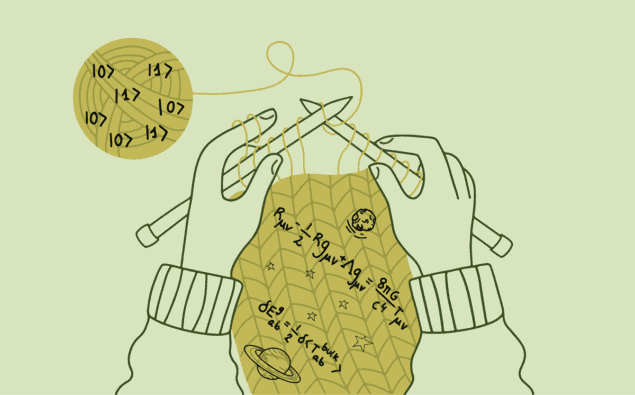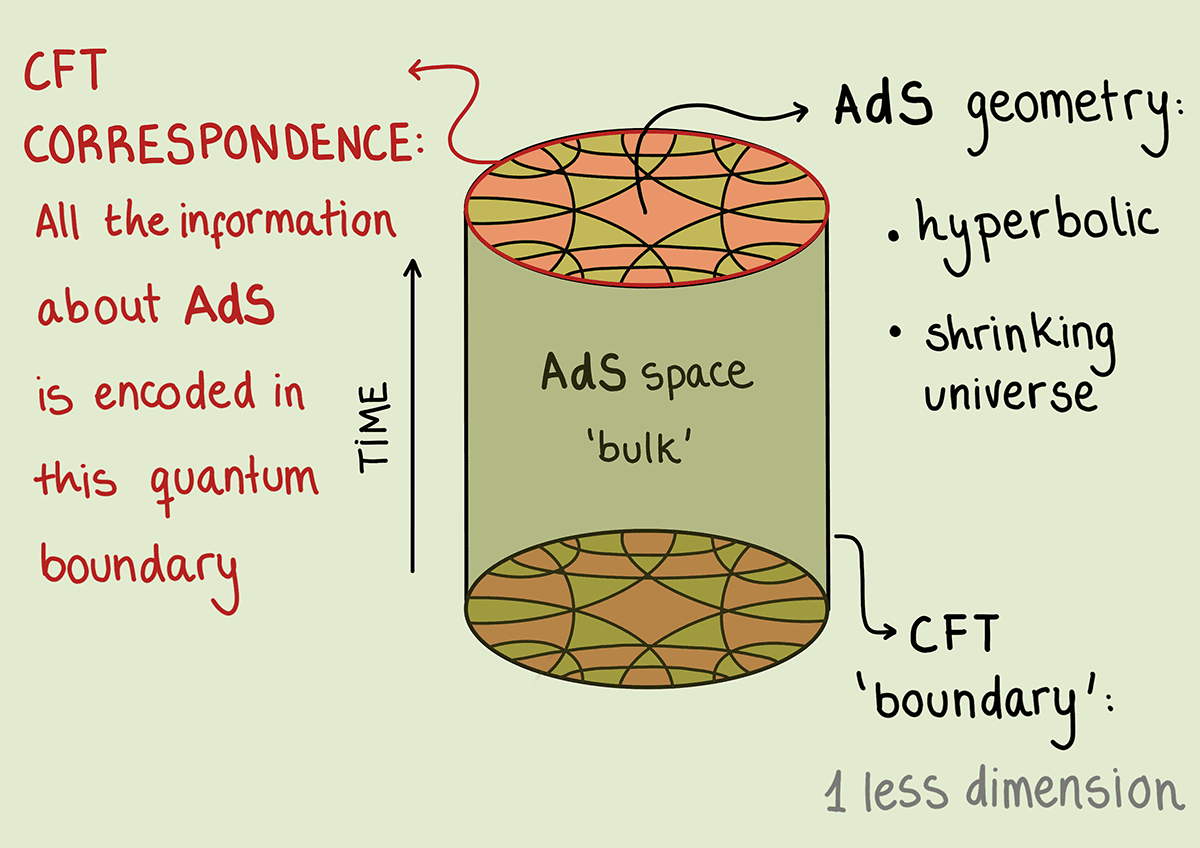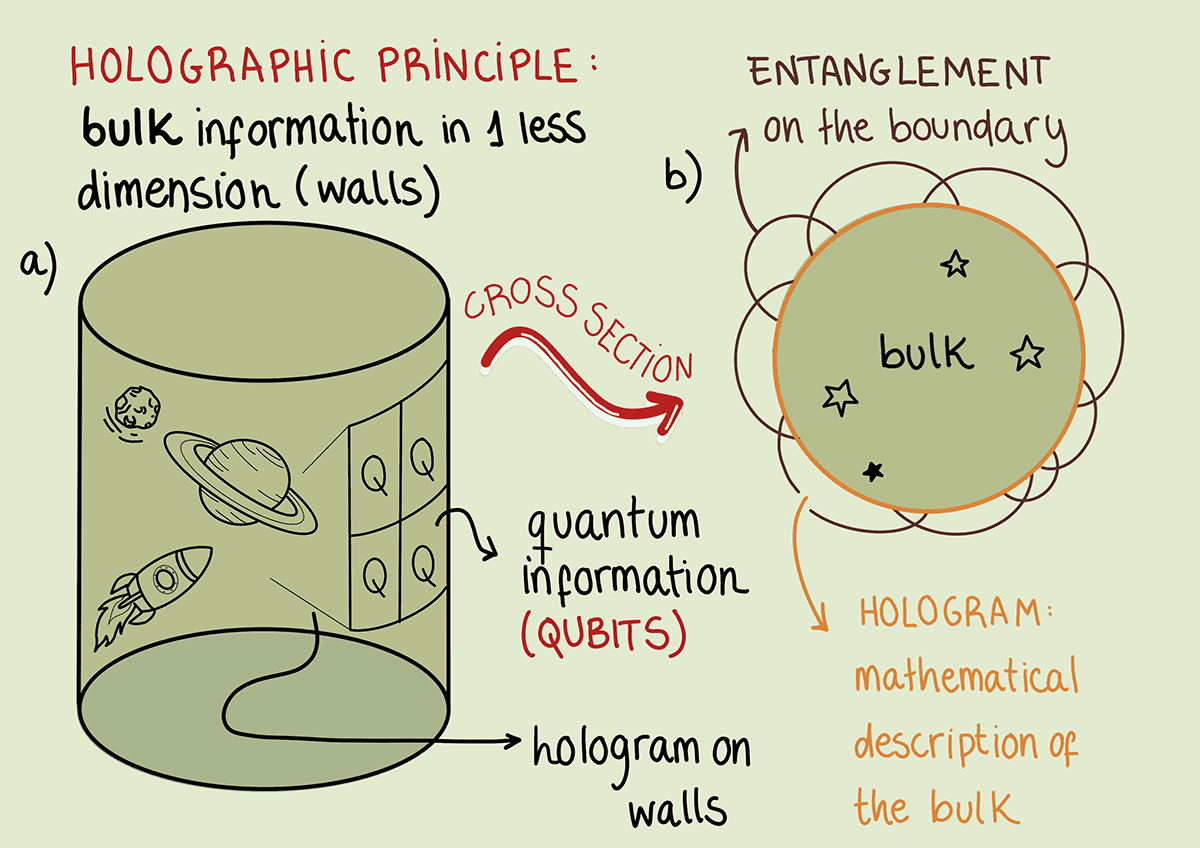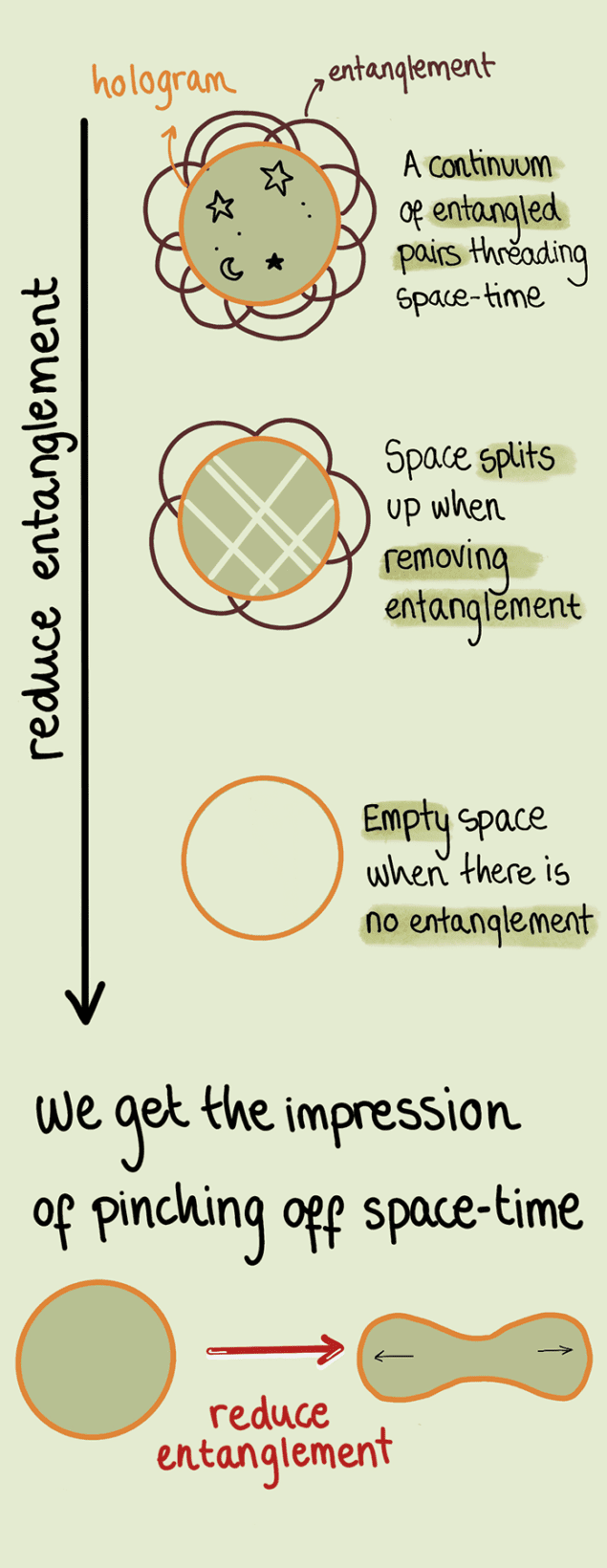Clara Aldegunde goes on an intellectual journey to understand how quantum phenomena may thread together the fabric of space–time, giving rise to our reality

November 2021, Clara Aldegunde on Level 2 of the Central Library, Imperial College London, UK
I’m at the library, deeply engrossed in some research for my first article on quantum physics, when my phone rings and I snap back to reality. My parents are calling, and I hastily leave the silent study area to speak to them.
After the usual greetings and gossip, I can’t help but share with them what I’ve been learning. Some theorists, I’ve learned, think that quantum interactions are responsible for creating the space–time fabric of our universe. Using simplified models and mathematical tools, these researchers hope to explain how both space and time emerged. Although further investigation is vital to extrapolate this theory to a universe with the same characteristics as ours, this could be a promising first step towards quantum gravity and the long-sought “Theory of Everything”.
“Isn’t that exciting?” I ask my parents, who listen dumbfounded on the other end of the line. Carried away by the will to make them understand the incredibly deep implications of this concept, I find I have to begin by explaining the basics of quantum mechanics.
To truly get to grips with quantum mechanics, we must set aside our more classical mindset. Right now, there are two things I am sure of: I’m in South Kensington, London, standing at rest, explaining quantum mechanics to my family, and they are sitting on a sofa 2197 km away. If we were quantum particles, such as a proton and an electron, none of this would be true. In classical mechanics, we have definite answers when asked the position and momentum of a system at a given time. But cross the boundary from the classical to the quantum realm, and you’ll find, as physicists did in the early 20th century, that these rules break down.
At the quantum scale, one can never entirely accurately predict both the position of a particle, and its momentum, at a given time. And to describe any system, we need the wavefunction – a mathematical description of the quantum state of a system, which contains all its measurable information – to handle the probabilistic nature of quantum measurements. That’s why quantum particles are mathematically expressed in a way that embraces multiple possibilities, existing in a “superposition” of states at the same time. When we perform a measurement, the wavefunction collapses and picks a single definite value, corresponding to what we observe: a known definite measurement.
After giving my parents this rapid introduction, and suddenly thinking of the phone bill, I decide to go straight to the focal point of the article I’m working on: quantum entanglement. Too enthusiastic to wonder if they have been following my explanations so far, I try to clarify how this concept is “the characteristic trait of quantum mechanics, the one that enforces its entire departure from classical lines of thought” – just as Erwin Schrödinger declared almost 90 years ago (Math. Proc. Camb. Philos. Soc. 32 446).
Entanglement is a purely quantum-mechanical phenomenon, whereby two or more particles can have a closer relationship than is allowed by classical physics. It means that if we determine the state of one of particle, it instantaneously fixes the quantum state of the other(s), no matter how near or far they may be. It also means that if two such entangled particles are in a superposition of states, the collapse of the wavefunction of one of them means the instant co-ordinated collapse of the other. This strong correlation seems to transcend space and time, such that we can determine the state of one particle simply by measuring its entangled pair, no matter the distance between them. For example, if you know the spin of one particle, you can always determine that of the other. Could it be, perhaps, that it is this deep quantum connection between fundamental particles that threads together space and time?
But what are we ultimately looking for, and what would such a quantum space–time look like? Albert Einstein ousted Isaac Newton’s law of universal gravitation with his general theory of relativity (GR). It describes gravity as a geometric property of space–time, wherein the energy and momentum of matter and radiation directly determines the curvature of space–time – but GR is also formulated within the confines of classical physics. In an effort to unify quantum mechanics and gravity, researchers have long been on the hunt for a consistent theory of quantum gravity. One tempting solution is rooted in the aforementioned idea that, perhaps, the very fabric of space–time may be an emergent property of some kind of quantum entanglement; one that ultimately satisfies Einstein’s relativistic field equations.
“Doesn’t it feel like magic?” I ask my parents. Their bewildered silence doesn’t shake my enthusiasm. After I get off the phone and return to my desk, I picture myself as the pioneering theoretical physicists Juan Maldacena and Gerard ’t Hooft, thinking back to when they were on the precipice of discoveries that started to illuminate the links between the quantum world and space–time.
[Disclaimer: although the scientists featured below are real, the scenarios and quotes are fictional, imagined by the author for the purpose this article]
Building a quantum space–time

Gravity is a force that determines how objects interact with one another on a large scale. On a much smaller end of the scale – where gravity plays a near negligible effect – are the fundamental particles that make up everything in our universe, and their interactions are determined by the laws of quantum mechanics.
Quantum field theories are frameworks that combine classical field theory (which tells us how fundamental particles and fields interact), special relativity (which gives us an equivalence between space and time) and quantum mechanics. They apply to three of the four fundamental forces in the universe – the electromagnetic, strong and weak forces but not gravity.
Unfortunately, the general theory of relativity (GR) – which describes how gravity and space–time work in our universe – is not compatible with quantum mechanics. Indeed, GR says that space–time is continuous, whereas quantum mechanics dictates that everything is in discrete quantized packets of matter and energy.
To unify gravity and quantum mechanics, physicists and mathematicians have long been working on developing a theory of quantum gravity. In an attempt to show how a region of space–time with gravity could potentially be derived from a purely quantum theory, in 1997 Argentinian theoretical physicist Juan Maldacena proposed a conjectured link between two physical theories, which he dubbed the anti-de Sitter space/conformal field theory correspondence (AdS/CFT).
On the one hand are anti-de Sitter spaces (AdS) – a particular kind of space–time geometry that is used in theories of quantum gravity and is formulated in terms of string theory. On the other hand are conformal field theories (CFT) – a special version of quantum field theory that is invariant under conformal transformations. These transformations are such that the angles and velocities of a space–time are preserved and remain unchanged, despite any other changes, such as a change in scale. Unfortunately, this does not hold true for the quantum electrodynamics we observe in our universe, as a change in scale would impact the charges and energies of fundamental particles and fields, meaning that the quantum fields we observe in our reality are not described by conformal field theories.
Maldacena’s AdS/CFT correspondence postulates that these two theories provide two different descriptions of the same physical phenomena. In his proposed universe, the AdS is a space–time region that emerges, like a hologram, from the CFT, the gravity-free boundary of this holographic universe. Indeed, the 3D AdS has gravity, and is negatively curved (imagine a saddle shape), which allows it to have a boundary – the 2D CFT, which does not include gravity.
The lower-dimensional boundary is what gives rise to the so called “holographic principle” or duality that gives us two different ways of looking at the same system – just like in a hologram, where all of the 3D information is stored on a 2D surface. As the CFT has one fewer dimension than the AdS space, you can picture it as the 2D surface of a 3D cylinder – one where the quantum mechanics at play on surface includes all of the information of the bulk. And as it happens, it is the quantum entanglement in the boundary that gives rise to the space–time geometry in the bulk.
January 1998, Juan Maldacena in the living room of his home near Harvard University, US
After a long day at work, you (Juan Maldacena) arrive home to find your two-year-old daughter in the living room, surrounded by her toys – miniature versions of everyday objects. You have just published a paper on how particular space–time geometries (“toy universes”) could be found to have certain correspondences to a type of quantum theory without gravity (more specifically known as a conformal field theory, CFT). And just as your daughter’s toys represent a version of reality that is much easier to handle, simplified versions of our universe make the problem of understanding the origins of space–time considerably more approachable.
Passionate about this beautiful symmetry, you start explaining to your daughter that her toys are just like anti-de Sitter space (AdS) – a multi-dimensional space–time with gravity that is used in theories of quantum gravity based on string theories. Indeed, AdS is the most used alternative space–time geometry to study this matter since you discovered the AdS/CFT correspondence (see box above).
By analysing this duality between a specific space–time geometry (easier to handle than our actual universe) and quantum mechanics, we have the right starting point to answer the most fundamental question of physics: what is space–time ultimately made of?
Your perplexed child looks on as you explain how even though an AdS universe is negatively curved and therefore is collapsing in on itself – as opposed to our positively curved and expanding universe – these simplified universes can be of enormous help when studying the physics behind quantum entanglement knitting space–time. “Solving challenging problems is much easier when you can divide them into not-so-challenging little parts,” you solemnly declare.
Nonetheless, there is still a huge conceptual roadblock: the maths of quantum physics operates in three dimensions, whereas space–time accounts for four. Luckily enough, your daughter need not be too concerned, as another theorist is already on the case.
1994, Gerard ’t Hooft in a lecture theatre at Utrecht University, Netherlands
You (Gerard ’t Hooft) are in your regular undergraduate lecture, surrounded by enthusiastic students who want you to explain to them a concept you introduced to the scientific community a year ago: the holographic principle. Developed as a solution for what happens when gravity, quantum mechanics and the laws of thermodynamics truly clash at the event horizons of black holes, the holographic principle suggests that a 4D space–time can be projected onto a 3D surface expressed by quantum mechanics. Just as a 2D array of pixels on a TV represents a 3D image, space–time can be mathematically described by this “hologram” in one fewer dimension.
The holographic principle suggests that 3D space could be threaded by fields that, when structured in the right way, generate an extra fourth dimension, giving rise to space–time. The lower-dimension hologram (3D quantum description) would serve as a frontier to the 4D bulk space, created thanks to entanglement on this boundary (figure 1). As the US theorist Ted Jacobson would later affirm in 1995, more entanglement would mean that parts of the hologram are more tightly connected, making deforming the space–time fabric more difficult, and leading to a weaker gravity as understood by Einstein.

“But what would happen if we mathematically took out the entanglement from this quantum-mechanical description that we called a ‘hologram’?” you rhetorically ask your students. “Well, we find that the space–time splits up. As a matter of fact, if we remove all the entanglement, we are left with no space–time.”
Your students don’t seem convinced, so you decide to go a bit further, introducing the concept of entanglement entropy. This is a measurement of the amount of entanglement between two systems, and theorists have been able to directly relate it to the surface of the bulk, finding that it is proportional to the amount of entanglement.
But to be able to make this connection, you say that we need to consider a continuum of entanglements, leaving the idea of discrete connections behind. When we do this and let the entanglement in the hologram tend to zero, the bulk area (where space–time lives) also vanishes, as would happen if we were to take the threads off a piece of cloth (figure 2).
You pause for dramatic effect, meeting the eyes of your most eager students one by one, before you ask, “Isn’t this a strong argument supporting that space–time is indeed fundamentally quantum mechanical, being held together by entanglement between different parts of the hologram?”
25 December 2021, Clara Aldegunde in the dining room of her family home
“Finally, a well-deserved break,” I think in the middle of the family Christmas dinner when I overhear my dad describing my article as being about “some interaction between particles that, who knows how, forms space and time”. Suddenly, I feel the need to make my whole family understand how vital this hypothesis is for modern physics. Driven by my passion and all the recent knowledge I have absorbed, I decide to have another go at explaining these ideas to them by introducing the concept of a quantum bit, or qubit.

A qubit is a quantum system with two (or more) possible states. While classical bits can take a value of either 0 or 1, qubits (characterized, for example, by the spin of the quantum particle) have quantum properties and can exist in a superposition of the states. And if these qubits are entangled, knowing the state of one of them would mean knowing the state of the other, a concept that could be easily extended to a collection of any number of qubits.
Entangling each qubit with its neighbour would give rise to a completely entangled 2D network, and entangling two such networks would result in a 3D geometry. I then realize that this relates back to ’t Hooft’s ideas, as entangled qubits creating one more dimension beyond the number of dimensions they occur in explains the existence of the bulk and the boundary introduced by the holographic principle.
“But if two distant points of the hologram are entangled to form the space–time bulk in between, and information is travelling from one quantum particle to another instantly, wouldn’t this mean surpassing the speed of light?” asks my aunt who, to my delight, is following my explanation.
In fact, this conceptual problem can be solved by arguing that entangled particles do not really have to cover the space separating them. The speed of light can still be a physical limit, as long as we understand that entanglement does not occur in space–time, it creates space–time. Just as a rock or an orange are made up of atoms but don’t exhibit the properties of atomic physics, so the elements building space don’t need to be spatial, but will have spatial properties when combined in the right way.
Apart from my aunt, most of my family look confused and are unimpressed by my revelation. But I realize that this discussion has cleared up several ideas in my mind, as it dawns on me how quantum mechanics became a geometry that could now be compared to space–time.
Over the course of the holidays, I long to get back to my research into trying to discover the origins of space–time. I take a break from the family festivities and find a quiet room to think about Stanford University professor Monika Schleier-Smith, whose team is working on reverse-engineering highly entangled quantum systems in their lab, to see if some sort of space–time emerges. I ponder how, in 2017, Brandeis University physicist Brian Swingle came to the conclusion that “a geometry with the right properties built from entanglement has to obey the gravitational equations of motion” (Annu. Rev. Condens. Matter Phys. 9 345).
2015, Monika Schleier-Smith replying to Brian Swingle’s e-mail from her office at Stanford University, US
“Yes, Professor Swingle, I can reverse time in my lab,” you (Monika Schleier-Smith) say in reply to the very specific question from Brian Swingle. In your laboratory, you are working to control entanglement between atoms so precisely that it becomes possible to reverse their interactions, in the hope that you can experimentally create space–time in your lab.
Theoretical CFT models are often too complex to handle with existing mathematical tools, so trying to find their gravitational (AdS) dual in the lab could be the better option, potentially entailing the discovery of simpler systems than the ones being studied theoretically.
To be able to experimentally test this hypothesis of the origins of space–time, you decide to tackle the problem the other way around. Instead of starting from our universe and trying to explain it through quantum calculations, you study how controlling quantum entanglement may produce space–time geometry analogues that satisfy Einstein’s equations of general relativity.
The desired entanglement geometry forms a tree-like structure, where each pair of entangled atoms is entangled with another pair. The idea is that such individual, low-level entanglement is built up into a completely entangled system. Connecting various structures of this kind gives rise to the space–time bulk, thanks to a circle of connections between different parts of the CFT surface.
The key to observing this emergent space–time in the lab is to trap atoms with light to cause entanglement, and then control them using magnetic fields. To accomplish this, your laboratory is brimming with mirrors, fibre-optics and lenses around a vacuum chamber that contains rubidium atoms, cooled to fractions of a degree above zero kelvin. The entanglement is then controlled using a specially tuned laser and magnetic fields, allowing you to choose which atoms are getting entangled with each other.
This set-up seems to create holography in the laboratory – you can reverse time at the quantum scale. You realize the enormity of this finding. It will lend experimental support to Swingle’s theoretical work, and most importantly allow the scientific community to test the connections between quantum mechanics and gravity, bringing us one step closer to unifying modern physics.
9 January 2022, 23:00, Clara Aldegunde in her study at Imperial College London, UK
After almost two months of researching, discovering and learning, I have finally submitted my article. Concluding this work gave me answers to questions I hadn’t even thought of. More importantly, it left me with hundreds more questions.
Is this thread I am following leading us towards quantum gravity and a Theory of Everything, the ultimate goal of physicists? That is to say, would this quantum model be able to unify general relativity and quantum mechanics under one unique explanation, giving rise to a single theory able to describe our whole universe?
Is this thread I am following leading us towards quantum gravity and a Theory of Everything?
The scientific community strongly supports this idea, and many physicists around the world are currently working on it, firmly expecting hints towards a unification theory. As I write in my recently finished paper, understanding entanglement as a geometrical structure would allow us to compare it to gravity and to check its correspondence with Einstein’s relativistic equations, thereby solving one of modern physics’ biggest quandaries.
Nonetheless, I’m left with the impression of having to make too many assumptions to connect quantum entanglement to the formation of the fabric of space–time. What am I missing, and what should I focus on as I begin my research career?
As I see it, the first problem to tackle would be to describe entanglement as the continuum version of discrete tensor metric in GR, which holds all the information about the geometric structure of a space–time. Once this is done, Einstein’s equations could be derived for this space–time model, explaining how gravity arises from entanglement for the simplified AdS space. The other key issue with an AdS universe is that its collapsing geometry looks nothing like our expanding universe, and several adjustments should be made to fully expand these findings to our reality.
Despite these open questions and concerns, this toy universe has provided both vital theoretical insights and the capacity to make some predictions; for example, volumes and areas scale the same way in AdS and in our universe.
What else can be done to illuminate the connection between entanglement and space–time? One idea would be to investigate more complex space–time structures, both mathematically (with tensor networks that, for example, represent black holes) or experimentally (as Schleier-Smith has only created simple space–time structures so far).
I remember the closing statement in Swingle’s paper: “Interestingly, the interior [of a black hole] continues to grow long after all entanglement entropies equilibrate, which is an observation that suggests ‘entanglement is not enough’.”
After reminding myself of all I have learned, I cannot help but feel extremely fulfilled. I let sleep take me, content in the knowledge that finishing my paper meant nothing but the beginning of my journey towards unmasking how the universe knits space–time.



